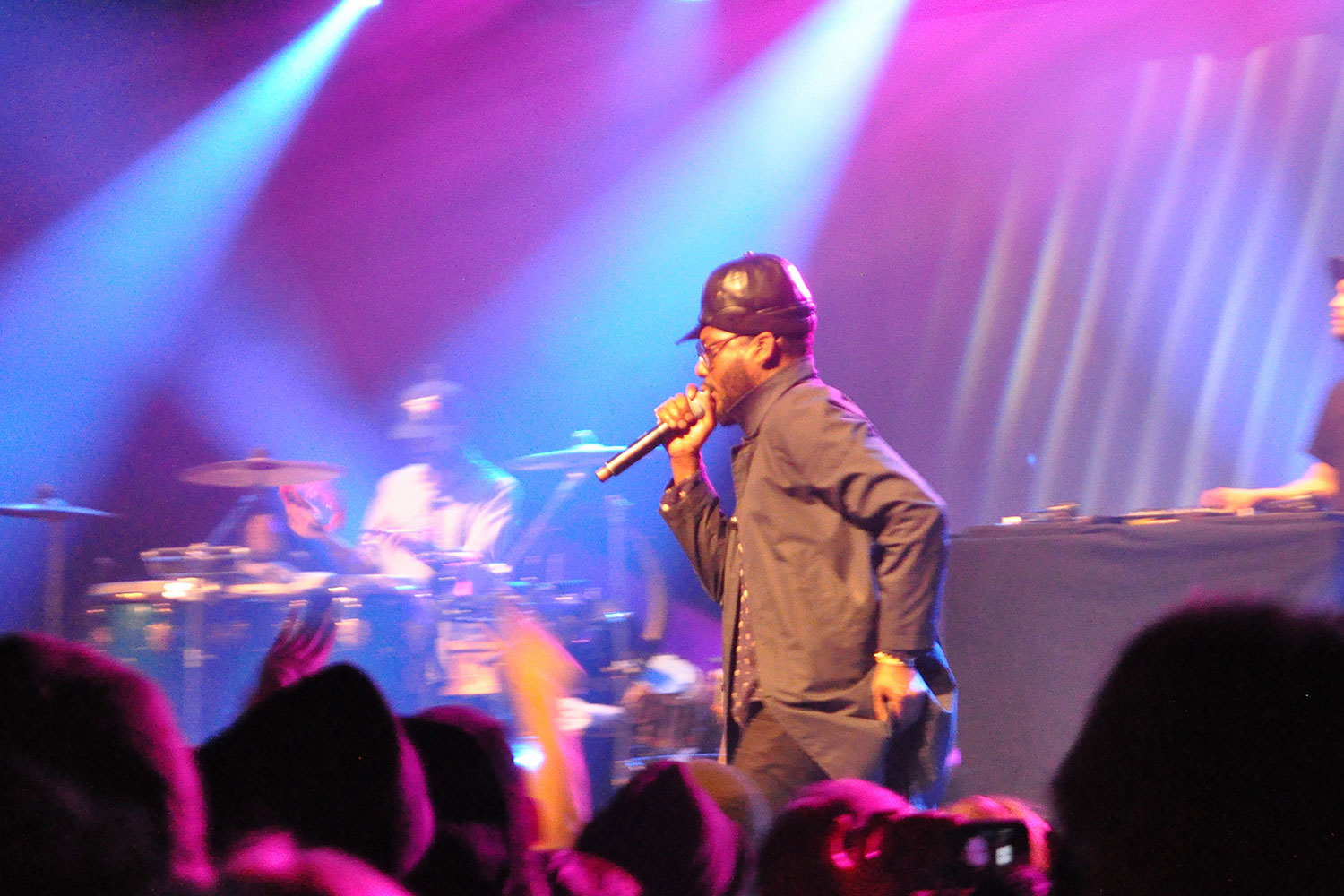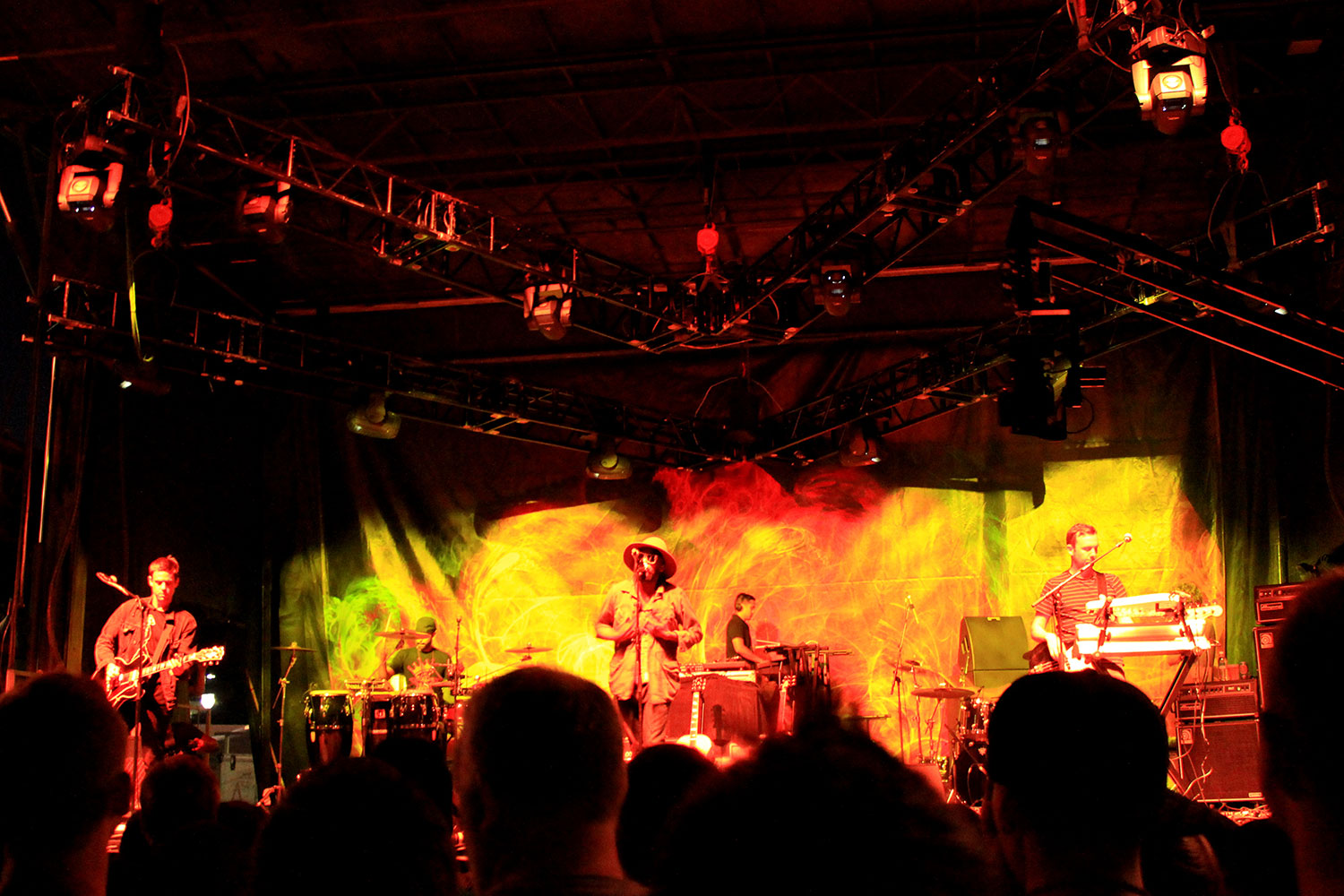
“You gotta be aware of everything that’s happening now, but not throw away everything you’ve learnt.”
Modern music is often at its most exciting when it’s a melting pot of genres and sonic flavors. Canadian rapper k-os has followed that mix-and-match maxim ever since his 2002 debut Exit and its 2004 follow-up Joyful Rebellion, which went platinum north of the border and snagged a score of Juno Awards to boot.
His new album Can’t Fly Without Gravity, out now on various formats from Dine Alone Records, soars with his expert sense of capturing that cross-genre energy, from the East Coast meets West Coast thrust of Wild 4 the Night to the “tongue kung-fu” lashing and mashing of Crucify, to the hard-rock splatter of Turn Me Loose.
“The reason this record sounds like it does is because I’m OK with coming from the vinyl era. I’m an albums guy. Fortunately, it’s making a comeback now, so it doesn’t seem that weird,” k-os says. “I know it’s delusional because we live in a singles era, but my whole concept of my musical life comes from vinyl and B-sides. It’s always going to be that way for me. I’ve tried changing to get with the times and get with the format, but whenever I’ve done that, it’s sort of gone astray.”
Staying true to his roots has kept k-os on the path of continuing to create new sounds and new beats. “From the moment you put it on, the sound and the aesthetic of the record is always going to have that high fidelity thing,” he explains. “I wanted to start the record on a jazz tip so that when you put the needle on the record, you’d say, ‘Here we go!’”
Digital Trends called k-os (real name: Kevin Brereton) at his homebase in Toronto to discuss how to merge analog thoughts with digital gear, saying no to Auto-Tune, and sampling Whitney Houston in an offbeat way. When you fall up, you fall down, and the sky becomes the ground.
Digital Trends: I love the way how all the sounds on this record converge. How do you reconcile being an analog guy in a digital world?
k-os: Well, it’s an interesting time right now because everything is very digital, but yeah, I come from an analog school of thought, obviously. I was talking to a DJ friend a couple of days ago, and he was like, “You know, it’s kind of funny how the boom-bap sound just died.” It wasn’t until he said it that I realized it was actually true. Those of us from that era — it never really died to us, but him being out there and playing out currently, he has to keep the crowd moving with the records he plays, and he has to be a realist.
“You gotta be aware of everything that’s happening now, but not throw away everything you’ve learnt.”
But now, the computer has taken over, and everything is in the brain of the computer. It’s changed. I’ve seen my younger cousin’s friends from this neo-hip-hop generation listen to a song for the first time just off the speakers of a computer. That’s how they listen to music, where there’s no real bass and you can’t really hear the kick [drum] in a certain way. Everything is in the mid-to-high range.
And for things to bang on a computer, everything really has to be crisp and buzzy; that’s why trap music works. The snares or the 808s pound through that, and there’s hardly a bass line. The 808 is usually the bass line. There’s really no melodical Sting bass line, or Flea bass line, or George Benson bass line — on a computer, you can’t even hear it on headphones.
I went into this album knowing every time I produced something or made a beat or a demo, I’d play it through the computer and be like, “OK, if I just opened up my computer and heard this, what would I get?” I worked with Michael Brauer, a guy who did Coldplay records. [Brauer was the mix engineer for 2000’s Parachutes and 2008’sViva La Vida.] He had a transistor radio in his studio, and every time he mixed something, he played the whole mix through this little crappy transistor radio. And that’s how I use the computer — as this transistor, because it’s sort of the same thing, ironically. (laughs)
A lot of the old-school rock guys would put their mixes on a tape or a CD and then go play it in a car to see how good it sounded over car speakers.
That’s the thing, right? So there it is. Sonically, songs like Vous Deux (Denzel Washington) and Crucify needed to have a retro feel with retro sounds, but with some digital and electronic elements. There has to be a little bit of spice in the salad to make it pop, you know what I mean? You gotta be aware of everything that’s happening now, but not throw away everything you’ve learnt.
What kind of gear and plug-ins did you use on this record?
I used a lot of Neve channel strips to get clean sounds, and the ASR-10 by Ensoniq. Please please please, I’m letting people know — I did not sequence on Pro Tools. I did not sequence on any outboard computer. Any sequencing I did was on the ASR-10. It’s a tricky machine to learn how to operate, but the way it quantizes, and its envelopes, are amazing.
I believe what’s happening in music today with Pro Tools is, it’s a glorified drum machine. A drum sampler. The sampling time I have with my ASR is 100 seconds. When you sample something, you are basically creating a sample of musical tones. If you sample something in the key of C, you can do anything with that now because you’re playing it up and down the keyboards. Whereas in Pro Tools, everything that’s flown in is done by “seeing” it. I’m not superstitious, but I don’t like “seeing” music like that. I feel like you have to feel it.
How do you keep yourself current as an artist and a producer?
“The reason why the color blue is attached to jazz is it puts you in a really cool mood.”
And jazz always comes into modern music. I think the reason why the color blue is attached to jazz is it puts you in a really cool mood. And if you really check it, dissonance is the opposite of Auto-Tune. There are people now who want things so on key that they’re using a machine to get back into key. But in jazz, if somebody hits a note that’s out of key — it’s kept.
I always think of Gimme Shelter, that Rolling Stones song where Merry Clayton’s voice cracks during one of the “Rape, murder!/It’s just a shot away” choruses. That’s real, and they left it in there because that’s the artist being in the moment. If you took that out, you’d lose the character of it. Auto-Tune genericizes all of that stuff now.
Yeah yeah, that’s exactly what I was going to say. For men, it takes the character right out of their voices, because there’s no vulnerability there. There’s this underlying robot protecting them from showing their true feelings. But that’s what a singer is supposed to be. Frank Sinatra is a great singer, but his vulnerability makes him an individual.
The vocals for this record were done on my iPod headphones. My engineer was like, “How did you get that? What filter are you using?” If you listen to the vocals, they sound kinda raw, but they’re not distorted too much. I have a very melodical, bassy, roundish voice, and I came up with this original tone. This is what people are listening to and the machinery people are listening to music on, so when I do vocals on iPod headphones, it cuts immediately. You can put up a Neumann or a [Shure] SM7, one of the best mikes in the world, but who cares? Once it gets on a computer, it doesn’t really matter what mic you’re using.
You gotta relate to how your audience plays back your music. When you’re talking about keeping your voice real, I think of that really throaty vocal you’ve got going on Steel Sharpens Steel.
The verses for Steel Sharpens Steel were done on iPod headphones, but for the choruses, I would double the vocal on a Neumann or the SM7. You have that feel when you listen to that song that it’s super-raw, but then you get the real ear-candy parts on the bridges and choruses. I was very aware I wanted a raw sound there, but the singing part really needs to shine and be fuller and sound real-er, with less of an “imaginary” voice.
Again, a lot of it is intuitive. I try not to technicalize a lot of stuff. I’m not a trained musician and I didn’t learn production from anyone — I went to the hip-hop school of production, where your ear is trained to pick out what sounds good. (chuckles)
What’s a benchmark album to you in terms of sound quality and production quality?
“Dissonance is the opposite of Auto-Tune.”
Why I say The Strokes, or any of the Led Zeppelin records or Bob James, whatever record Nautilus was on [1974’s One]. He played electric Rhodes piano, and that’s a very clean sound, where the drumming and the bass lines on that record were very dirty. Nautilus is the pinnacle in sound, to me. It sounds like a hip-hop song, but it’s a jazz song, and it’s a pop song. It sounds like Steely Dan too. It has that vibe to me.
It really cuts through. I think Boys II Men may be my favorite Gravity track right now. It’s got that way-out-of-key, RZA kind of thing going for it.
Totally. That’s a lot of people’s favorite track. I woke up one day, and I don’t even know how I came up with that song. But once I sampled the Whitney Houston part [from I Will Always Love You], everything worked around it.
Sometimes I’d play it for people and ask, “Is this weird to you?” This is the dissonance thing. Music now is so clean and tuned so that when you hear this, it relaxes you and says, “Hey, it’s OK if something doesn’t sort of fit.” There’s a coolness about it, and it almost makes you feel cool listening to it. Someone just threw away the rulebook and said, “I’m just going to do this, and I don’t care if it’s in key or not.”
Did you know right away you were going to play with that Whitney sample?
I had the drum break and a couple of the weird keyboard sounds and I was like, “If you use it, it will work.” But I’m also a singer, and I always wanted to sample her. The beginning of I Will Always Love You is just straight a cappella. I had these songs in mind where they’d come across the iPod or on the radio and I’d go, “One day I’m going to use this.” You note it.
We stockpile things in our brain that we’re going to use one day, and when you can do that and it fits and it works, it sounds like it was meant to be there. That’s what makes the song kind of ironic and cool — you have this non-melodic weird thing with one of the best singers in the world totally doing her thing on top of it.
I think a lot of people won’t even know that’s Whitney Houston. In a way, that sucks, but in another way it’s good, because she sounds so classic, it could be a Nina Simone sample. That’s the level of genius she’s on now. You sample Whitney Houston in 2015, it sounds like Ella Fitzgerald. It’s a beautiful thing.

























